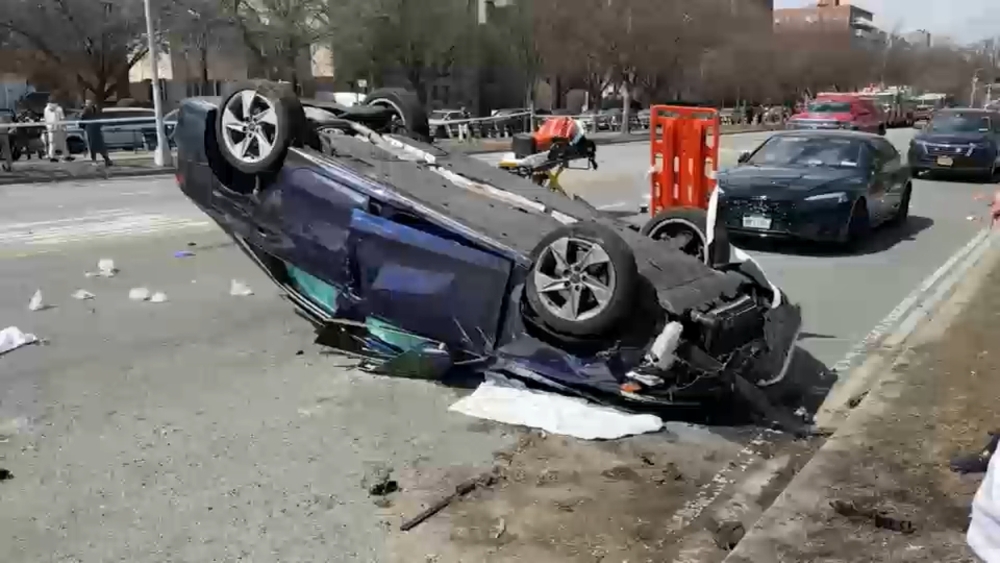|
Getting your Trinity Audio player ready...
|
Brooklyn’s Ocean Parkway: A Boulevard of Broken Safety Promises, as Tragedy Strikes Again
Edited by: Fern Sidman
Ocean Parkway in Brooklyn — a stretch of road with a reputation for danger and deadly speeds — is once again under scrutiny after a horrific crash claimed the lives of a mother and two young children, leaving another child clinging to life. The tragic incident, which unfolded over the weekend, has renewed outrage among residents and safety advocates alike, many of whom have long warned that this major artery is a perilous corridor in desperate need of reform.

According to a report that appeared on Tuesday in The New York Post, the latest fatal crash involved 32-year-old wigmaker Miriam Yarimi, who allegedly tore through the intersection of Ocean Parkway and Quentin Road in her Audi A4, colliding with an Uber before veering into a group of pedestrians. The victims included 7-year-old Diana Saada, 5-year-old Deborah Saada, and their mother, Natasha Saada — all of whom were killed on impact. Four-year-old Philip Saada survived the crash but remains in critical condition.
Sources told The New York Post that Yarimi, who has a history of reckless driving, told first responders she “had the devil in me.” She is currently undergoing a psychiatric evaluation and faces charges of manslaughter, criminally negligent homicide, and assault. The charges are made all the more alarming given Yarimi’s driving record: her license was suspended, and she had accumulated a staggering 93 traffic violations.
For years, Ocean Parkway has been flagged by community members and transit safety groups as one of Brooklyn’s most hazardous thoroughfares. The New York Post notes that since 2014, at least 20 people have died on this five-mile stretch of road, and nearly 2,400 others have been injured since 2012.
Activists have repeatedly urged city and state officials to impose stricter safety measures — including lowering speed limits, installing more red-light cameras, and redesigning intersections to better protect pedestrians. Despite these calls, little has changed.
Ben Furnas, executive director of the advocacy organization Transportation Alternatives, told The New York Post that the latest crash should serve as a clarion call. He placed partial blame on Albany lawmakers for failing to act on proposed legislation that would have required drivers with dangerous records — like Yarimi — to install devices that prevent cars from exceeding speed limits by more than 5 mph.
“If Albany had passed this bill last year, it could have already saved three lives,” Furnas told The Post. He also described Ocean Parkway as a “wide and dangerous road plagued by super speeders.”
Locals say this tragedy was both foreseeable and preventable. Sofia Khavin, a 36-year-old mother who regularly walks with her nine-month-old son near the same intersection, told The New York Post that reckless driving is a routine terror.
“We just happened to be at a different place on Saturday,” she said. “When we learned about the accident, we were horrified. It really hit close. I cross there all the time with my baby. They [drivers] go faster than 25 mph. They run the red light, they make illegal turns. There are no cameras at this corner.”
Her story is echoed by countless residents who feel the city has abandoned them to a daily gauntlet of aggressive drivers and insufficient protections.
Ocean Parkway’s dangers are stark even when compared to other infamously treacherous New York City roads. As The New York Post report highlighted, the nearby Ocean Avenue — which also cuts through residential areas — saw seven fatalities and 1,710 injuries over the same decade-long span.
Queens Boulevard, long dubbed the “Boulevard of Death,” had 22 deaths and just under 3,100 injuries since 2012. Ocean Parkway’s toll — 20 deaths and 2,400 injuries — places it firmly among the most dangerous corridors in the city, raising urgent questions about why its risks remain unaddressed.
This weekend’s catastrophe fits into a broader, disturbing pattern of vehicular violence that disproportionately affects pedestrians and families. What makes this case especially galling, as The New York Post report emphasized, is the preventability of the tragedy. Yarimi’s extensive record of violations and a suspended license should have already disqualified her from being behind the wheel.
The fact that no intervention was made — either by city officials, law enforcement, or traffic courts — reflects what many residents see as a systemic failure.
In the wake of the crash, pressure is mounting on state legislators to revisit the stalled bill that would mandate speed-controlling technology in vehicles driven by repeat offenders, as per the report in The New York Post. Safety advocates argue that this is not simply a matter of enforcement but one of technological intervention — a necessary step when human behavior proves persistently reckless.
Despite the installation of speed and red-light cameras, the arterial roadway is still the 19th most dangerous street for pedestrians in Brooklyn, according to data reported by The New York Post, which has consistently chronicled the Parkway’s troubled legacy.
While the city’s Department of Transportation (DOT) touts reductions in the posted speed limit to 25 mph and the placement of traffic enforcement cameras at various locations along the five-mile stretch, advocates and residents argue that these measures have failed to create meaningful safety for those who live, work, or simply cross the thoroughfare. Ocean Parkway — despite a name that evokes calm and leisure — continues to be a place of daily danger.
For Sandy Lee, a manager at the nearby European Wax Center and a mother of three, the illusion of safety created by camera enforcement quickly evaporates behind the wheel. As she told The New York Post, drivers routinely manipulate the system: slowing just enough to avoid a ticket and then accelerating as soon as they pass a monitored zone.
“They do have lots of speed cameras but people slow down and then speed up again until they get to the next camera,” Lee observed. “I am not surprised it happened but I’m surprised at how it happened — so many lives lost.”
Her words speak to a widespread perception in the neighborhood that enforcement, while visible, is fundamentally ineffective. Tickets may be issued, but the core problem — unchecked reckless driving — remains.
Since the fatal crash that killed Natasha Saada and her daughters, Diana and Deborah, while leaving 4-year-old Philip fighting for his life, a makeshift memorial has blossomed near the site, The New York Post report said. Flowers, teddy bears, and balloons surround the base of a tree, a small, heart-wrenching tribute to lives lost on a street long known for vehicular chaos. The memorial was started by Stephanie Benshimol, a retired teacher who, like many locals, has seen too much heartbreak on Ocean Parkway.
“There is constantly somebody dying on Ocean Parkway because people don’t obey the laws,” Benshimol told The New York Post. Though she supports the 25 mph speed limit, she questions whether it goes far enough. “If they want to lower it to 20 mph on such a busy street, then perhaps they should. But a camera is just a ticket.”
Her remarks reflect the growing frustration with a traffic enforcement system that punishes after the fact but does little to deter the root behaviors that make crossings perilous.
Even as Mayor Eric Adams signals openness to lowering the speed limit to 20 mph in the aftermath of the crash, the path to real reform is littered with political and bureaucratic obstacles. As The New York Post reported, any further safety changes must be coordinated with the New York State Department of Transportation — because Ocean Parkway is classified as a state road.
This jurisdictional split has long stymied more aggressive safety interventions. And in some cases, it’s not just inertia that blocks reform — it’s active opposition.
State Senator Simcha Felder, who recently won a special election to fill a City Council seat representing the crash area, has previously opposed even the 25 mph speed limit now in place. According to The New York Times, Felder once proposed raising the speed limit to 35 mph. In the wake of the recent tragedy, Felder offered no indication of shifting his stance. In a tweet quoted by The New York Post, he warned against “using this tragedy as an opportunity to advance [an] agenda,” suggesting that calls for reform are premature.
“There is a time to act—but there is also a time to mourn, to come together in grief, and to offer strength and support to those who need it most,” he wrote.
But for many in the community, the time to mourn is every week, every month — every time another crash ends a life.
Following the crash, a mobile NYPD command post was deployed near the intersection, and officers have been distributing safety pamphlets to locals. While this response may provide a temporary sense of action, it sidesteps the long-term need for redesigning the roadway itself.
Ocean Parkway, with its wide lanes and limited physical protections for pedestrians, invites speeding — a fundamental design flaw. Ben Furnas has described it as a “wide and dangerous road plagued by super speeders,” as reported by The New York Post. These comments echo the longstanding consensus among urban planners that without street redesign — narrower lanes, more pedestrian refuges, protected intersections — behavioral change cannot be reliably enforced.
The Vision Zero initiative, launched under Mayor Bill de Blasio in 2014, set ambitious goals: to eliminate traffic deaths entirely. While some gains have been made in select neighborhoods, the continued carnage on streets such as Ocean Parkway reveals deep cracks in the city’s approach. According to data reported by The New York Post, over 20 people have died on Ocean Parkway since the program began, and nearly 2,400 others have been injured.
These statistics are not mere numbers — they are families shattered, futures erased.
As New York City debates its next move, the question is no longer whether a tragedy will occur on Ocean Parkway, but when. With every day of delay, the risk remains that more flowers will be laid at makeshift memorials, more families will grieve, and the city’s promises of safety will ring increasingly hollow.




